Adolphe Appia: ‘Luminous – Very Luminous’

I.
In a melancholy mood, the Swiss scenographer Adolphe Appia sat down at his drawing table in the little bed-sit he was renting in Geneva and took up his pencil and a little hardbound notebook to write down his ‘notes personelles / 1905’:
‘At my age, that of forty-three, I ought to be presiding over a large workshop in which stage scenery is fabricated and painted; I ought to possess a private studio in which to compose and execute drawings and models; I ought to be constantly active on the stage – directing rehearsals and supervising performances. But above all, for the sake of my mental health and my spiritual wellbeing, I ought to regularly experience that singular happiness that comes with witnessing one’s work attain its highest realisation – the performance. Instead, I am increasingly isolated, increasingly estranged from the theatre, and from other artists.’ [1]
The despondent scenographer was not always so. At first he intended to become a musician, enrolling at the nearby Conservatoire de musique de Genève in 1880 when he was eighteen. After two years he moved on to the famed Hochschule für Musik und Theater in Leipzig, then to the Conservatoire de Paris, and finally back to Germany, where he finished off his studies in Dresden in 1888. Although his education was roaming, his passionate devotion to the work of the imperious German composer Richard Wagner was steadfast. Appia referred to him variously as Meister, Genie, Schöpfer (creator) or Wort-Tondichter (word-tone-poet), and one of his relatives later recalled that Wagner had even taken the place for him of ‘religion, of love, of everything’. [2] The only actual performance Appia saw under the Meister’s own direction at the Festspeilhaus in Bayreuth was Parsifal, a reformulation of the chivalrous coming-of-age quest for the holy grail, for which Wagner had coined the grand neologism Bühnenweihfestspiel, or ritualistic-festival-transposed-onto-the-stage. Although profoundly moved by what he heard, Appia was terribly disappointed by the conservatism of the opera’s romantic imagery and also by the ungainly techniques of stagecraft that were used to transition between scenes.
Appia decided that a fundamental reform of the staging of Wagnerian drama was required and he committed himself to that mission. He immediately set about articulating and illustrating his ideas that centred upon his radical conviction that the mise-en-scène was immanent in the musical score itself, and that additional scenic instructions were unwarranted, even discarding Wagner’s own written directions:
‘The musical score is the sole interpreter for the director; whatever Wagner has added to it is irrelevant … his manuscript contains by definition the theatrical form, its projection in space; therefore any additional remarks on his part are superfluous, even contradictory to the aesthetic truth of an artistic work. Wagner’s scenic descriptions have no organic relationship with his poetic-musical text.’ [3]
Appia toiled away during the late 1880s and early 1890s on a book that was to be a full explication of his theories, and for which he thought up the title Musique et la mise en scéne. But unable to find a French publisher he re-wrote it in German as Die Musik und die Inszenierung for publication by Bruckmann Verlag in 1899, by which time he was thirty-seven. Caught between languages (once confessing: ‘my misfortune is that I think in German and write in French’), he was never able to articulate his ideas to his own satisfaction, writing about his trepidation in the preface to the German edition: ‘Above all, my hand is unaccustomed to the pen, and besides that, the topic that I have addressed concerns an element – music – which, more than every other, evades analysis.’ [4] Whether or not Appia’s writing was satisfactory, his chief innovation and the source of such vitality later on, certainly was. This key insight was that light itself could create a physical space that would be profoundly attuned to the music in a way that traditional two-dimensional painted scenes never could be. ‘The word-tone poet paints his picture with light’, [5] he wrote, insisting on the fundamental importance of illumination. Having stated his premise, Appia went on to distinguish two different types of lighting: gestaltendes Licht (forming, sculpting or shaping light) and verteiltes Licht (distributed light) or more generally Helligkeit (brightness). The first was generated by directed lighting that cast precise shadows to evoke ‘the moon in the night, a fiery torch or a supernatural apparition’. [6] The second, on the other hand, was a kind of all-pervasive, directionless illumination that could be ‘tuned’. Appia also refers to this second kind of lighting as Transparentenbeleuchtung, or transparent illumination.
The other significant inclusion in Die Musik und die Inszenierung was a selection of equally atmospheric charcoal and pastel drawings for Wagnerian settings, which Appia had been working on since at least 1892. They are introduced to the reader in almost apologetic terms: ‘The drawings that follow make no artistic claims. The setting for a word-tone drama only exists while it is being performed; outside of the performance it can merely be technically apprehended, much in the same way that music is denoted in the score, or in the material conditions of the instruments of the orchestra or the bodily organism of the actor. In order to make the drawings somewhat palatable, and to make a positive impression on the reader, the author has attempted to give them more relief through certain “painterly” features, thereby half-way compensating for their lack of “life”.’ [7]
Having assiduously outlined and illustrated his far-reaching proposals for a reform of the staging of Wagnerian drama, Appia’s next step was to seek an audience with Richard Wagner’s widow Cosima, a formidable individual about whom a philosopher no less formidable than Friedrich Nietzsche once wrote: ‘There is one single case where I acknowledge my equal – I recognise it with profound gratitude. Frau Cosima has by far the noblest nature.’ [8] As noble as her nature might well have been, it was one that had no time for Appia: she ignored every one of his entreaties for a meeting. And yet he was undeterred, deciding that perhaps the way to go would be to send an envoy – his friend Houston Stewart Chamberlain – whom he duly armed with a package of writings and drawings. After his first visit to the familial Haus Wahnfried, Chamberlin reported to his friend on his progress: ‘Madame Wagner tells me that she will read your brochure “in due course”, although she doesn’t expect to find anything of interest to her.’ [9] She was even less impressed with the drawings. Chamberlain recalled that after having presented a folio of them to Cosima, he ‘could hardly see her face, because she had turned the same colour as the tablecloth, into which she seemed to be vanishing’. Exactly which drawings she reviewed is unknown, but Appia learned that on another occasion Cosima compared what was likely to have been his 1892 design for Das Rheingold – a cool blue evocation of the monumental setting for the Valhalla landscape – with the desolate ice fields of the North Pole. [10]
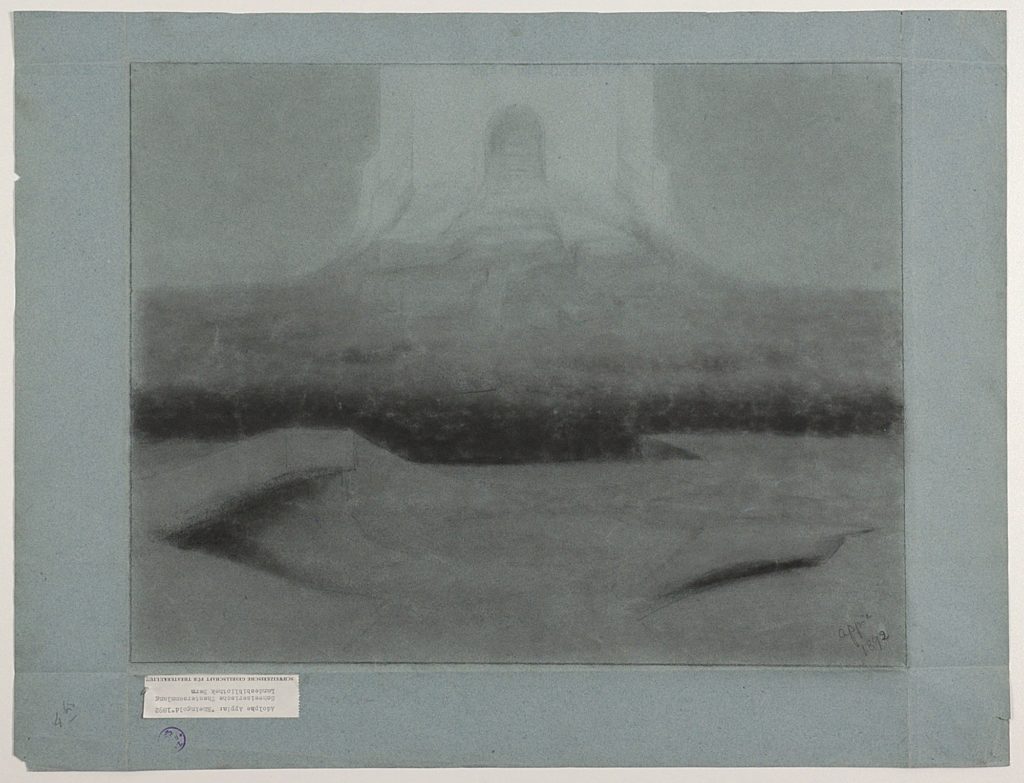
Rejected and belittled by Cosima – on one occasion she asked Chamberlain whether it was too late for him to become something ‘useful’, suggesting a costumier or a lighting technician [11] – Appia suffered a crisis of faith and roamed around Switzerland for the next few years working odd jobs on farms in the countryside or picking grapes on those steep terraced hillsides that rise from Lake Geneva all around its pebbly shores, before finally making his way back to the city that gives the lake its name. That is where Appia found himself in 1905, lonesome and writing down his notes personelles.
Thankfully, and not only for the sake of his spiritual wellbeing but also for his corporeal existence – at one point he even wrote a will, which he ominously posted to his sister in case he should ‘die suddenly’ [12] – his prospects soon brightened, on account of an encounter in May 1906 at the Conservatoire de musique de Genève, back where he had first enrolled as a music student twenty-five years earlier. He was sitting in a lecture theatre once again, but this time it was to listen to Swiss music teacher Émile Jaques-Dalcroze speak about Eurhythmics, the technique of musical instruction that he had invented and that was described at the time as ‘a scientific method of utilising our natural instincts for rhythm in the acquisition of an intimate knowledge of musical construction, in the development of a more perfect co-ordination between mind and body, and in the creation of a new outlet for artistic expression’. [13] Appia was deeply moved:
‘Without changing my orientation, Eurhythmics freed me from too inflexible a tradition, and, in particular, from the decorative romanticism of Wagner… From that day on, I saw clearly the route my development would take. The discovery of the basic principles for the mise-en-scène could only be the point of departure; Eurhythmics determined my future development.’ [14]
Enervated, Appia enrolled in a 1908 short course on Eurhythmics at the Conservatoire that would be be taught by by Suzanne Perrottet, Jaques-Dalcroze’s Lieblingsschülerin. A photograph taken during a break between classes shows the scenographer in his Lieblingspullover – a striped nautical pull marin – and with his face framed by a heavy black beard and crop of greying hair. His right arm is cast around one of his six companions, amongst all of whom there is an evident camaraderie. One stands proud in his fashionable button-down shirt and suspenders, and two others are wearing white skivvies. All are well-groomed and are playing for the camera; although studying rhythm, they are an offbeat crew.

A year later he was still enthused by Eurhythmics and went back to the Conservatoire to see a performance for which Jaques-Dalcroze himself had prepared the staging. History repeated itself: as had been the case at Bayreuth twenty-seven years before, Appia was dismayed by what he identified as a profound disconnect between the wonder of what he heard and saw of the performers themselves, and the abjectness of their scenography. He later wrote: ‘I took up paper and pencil and designed two or three Espaces rythmiques every day with feverish determination.’ [15] Appia then parcelled them up and mailed the set to Jaques-Dalcroze, together with an accompanying note in which he grumbled that Eurhythmics students who always moved about on a flat surface gave the impression of ‘mountain climbers who were climbing the Matterhorn in bas relief’. [16] An unoffended Jaques-Dalcroze wrote back, and in fact as Appia later recalled: ‘He was greatly enthused when he saw my drawings, and I was convinced that, both for his sake and for mine, I had brought to realisation something convincing. The Raumstil (spatial style) for bodily movements had been found.’ [17]
By now, Appia had returned to his solitary ways and had taken up residence in the tower of a medieval Château perched alone on the pebbled lake shore of Lake Geneva, close to the city of Vevey. Appia rented two rooms in the Château de Glérolles from 1909-1919, and it was the closest the restless scenographer would come to properly settling anywhere. His long-time friend, Jean Mercier, wrote that Appia used a collapsible drawing board that could ‘easily be carried along whenever he changed residence’. In the Château Appia kept the table close to the window. ‘Lifting his eyes’, wrote Mercier, ‘he could see the mountains and the sky; lowering them he could watch the waves rolling against the walls of the tower’. [18] While the scenographer gazed out of his room towards the snow-capped mountains rising above the stable horizon of the lake, his austere yet mysteriously atmospheric Espaces rythmiques gaze towards their own distant horizons, framing scenes that are all part hopeful and part melancholic – caught somewhere between the primordial and the dreamily futuristic.
Appia made around 30 of his Espaces rythmiques that are imagined scenes for imagined performances, and that are mostly simply named for the scene that the viewer sees directly before them: ‘The Two Pillars’; ‘Terrace With Three Pillars’; ‘The Open Door’; ‘Door to the Left’. But others are more enigmatic: ‘Addiction’; ‘The Game of the Hills’; ‘The Grand Curtains of the Sky’. And yet others are somewhere in-between, such as Les cataractes de l’aube (Cataracts of the Dawn). It is haunted by the memory of that Rheingold drawing that Cosima had roundly rejected, but this time the setting is warmer and more promising; three heavy stone steps in the foreground face the viewer and stand before a luminous cascading landscape surmounted by a majestic mountain over which the sun will presently rise. Another of the drawings, Clair de lune (‘Moonlight’), also holds promise while containing an element of intrigue. Again there are heavy stone steps, but this time they run perpendicular to the picture plane up and to the left, and there are more of them; one shallow step, then a platform, then six more steps that rise to another platform that extends beyond the bounds of the drawing. The run of steps and platforms abuts a wall of carefully laid cyclopean masonry, above which there is an evenly illuminated slot of sky. What is beyond the wall is a mystery, but perhaps one that would be revealed to a viewer able to peer over it, standing atop the uppermost platform. The lower part of the drawing is cast in the shadow of the bright but low-lying moon off to the right of the drawing, and whose angle and height intimates that there is a right-angle return to the cyclopean wall, back towards us, the audience.
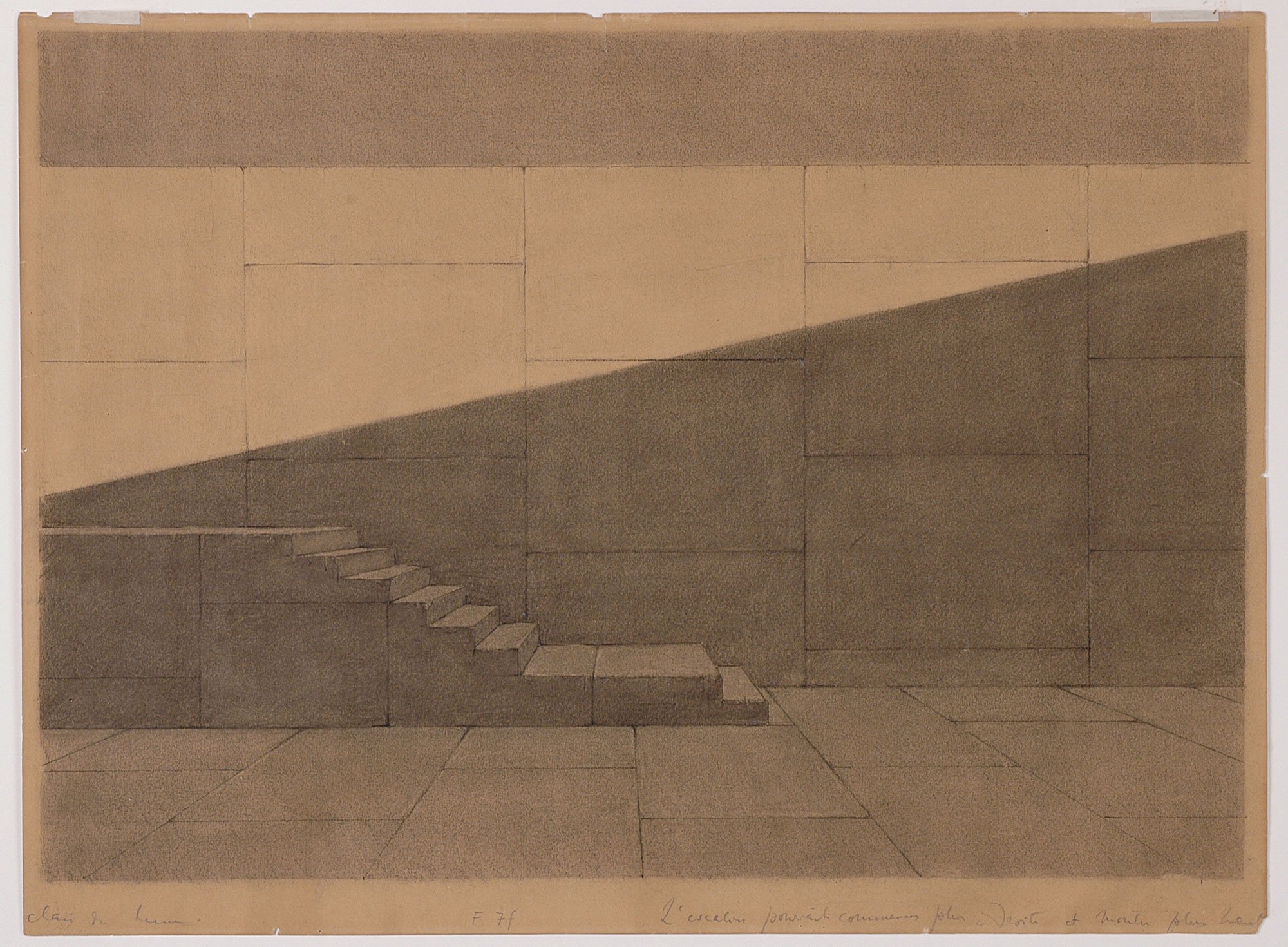
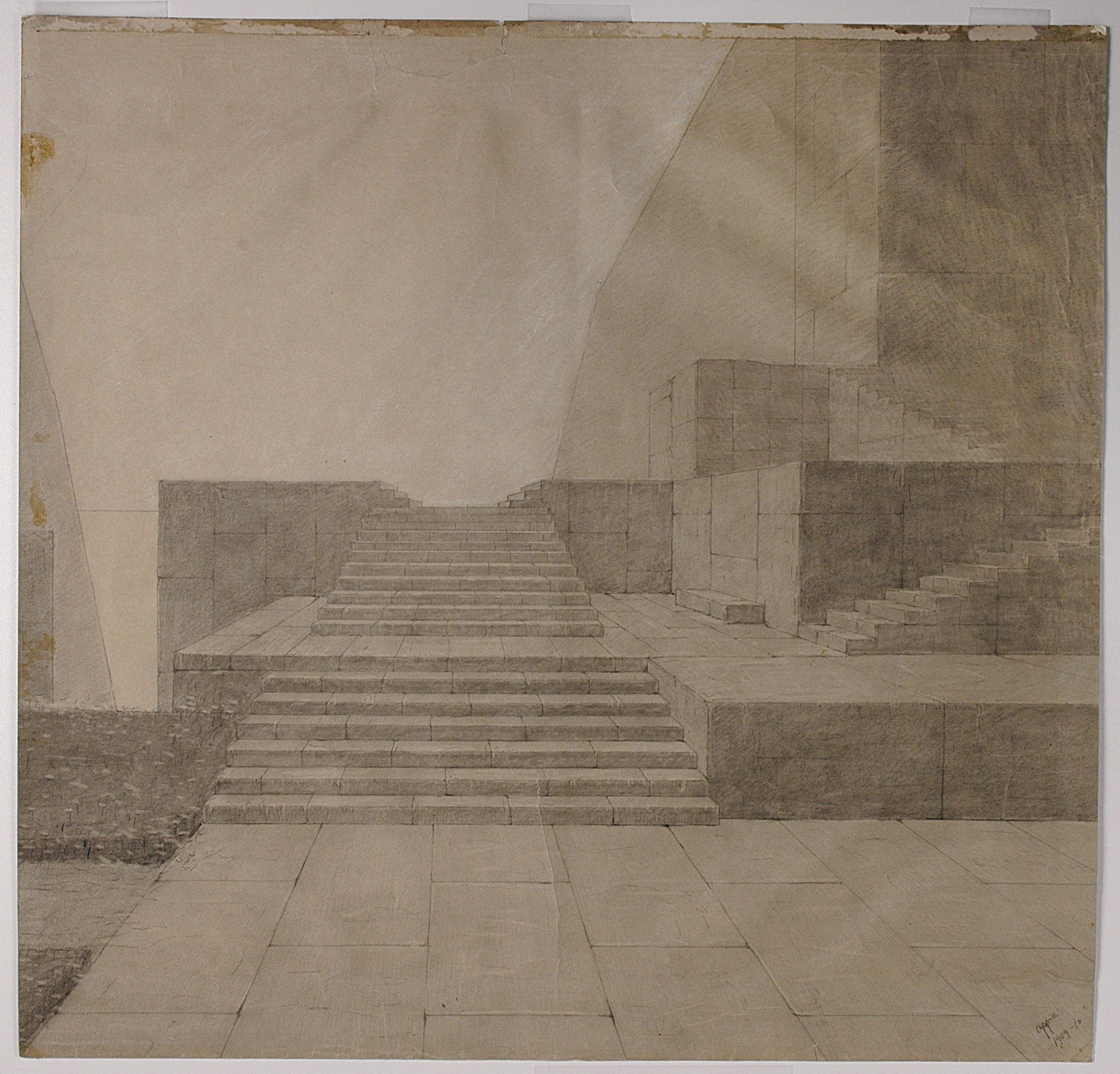
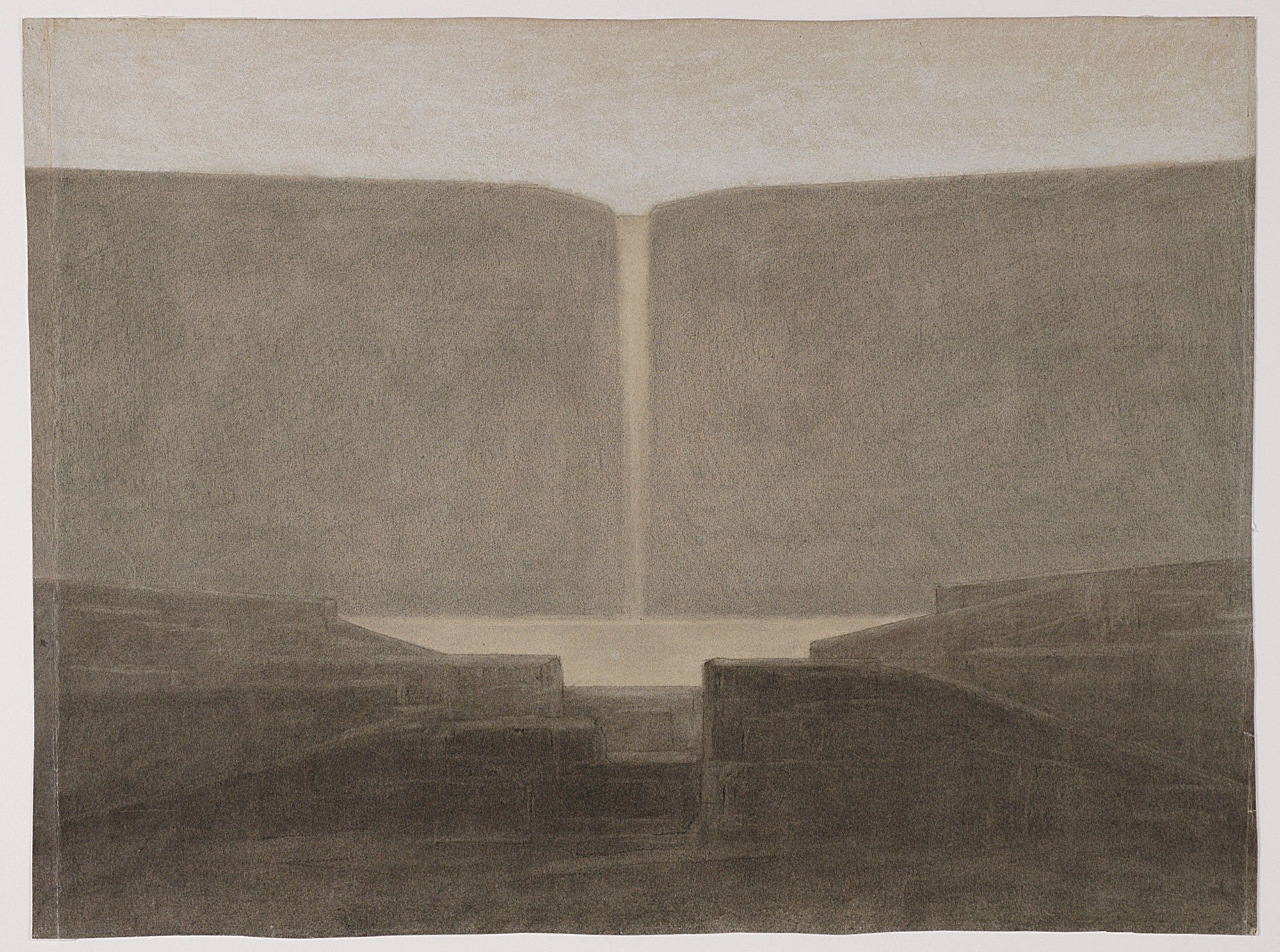
II
The major cache of Appia’s drawings dwell in the Swiss Archive of the Performing Arts, a modest cultural-philanthropic operation inconspicuously lodged in a re-purposed corner of a carpark under the Bern courthouse. Having double-checked the address and opening times – Wednesday and Thursday afternoons – on an information board under the kind of triple-vaulted glaucomic fibreglass awning produced for suburban bus stops in the 1980s, you step inside and find that the ceilings are low, the walls are windowless, and the furniture is sachlich but comfortable; it feels like a small-town library. The staff are eager, capable and affable, and they are capably supported by enthusiast-volunteers and interns working away quietly on the grey laminate-topped tables in the reading room. [19]
Roused from their resting place in the large plan-drawers in the room next door, Appia’s drawings are delivered for viewing one at a time. Up close they are revelatory; shimmering with those qualities that would have come to life through dramatic performance – through music, lighting, costumes and bodies, of both actors and audience. At first it is the variety – of theme, composition and atmosphere – that is arresting, but once you settle into them, it is the constancies, whether born of habit or conviction, that impress themselves. The carefully considered details and faint evidence of the techniques used to achieve them are only evident at close range – for example the sequence of light draughting lines that Appia used to set up his one-point perspectives, and then the tiny holes left by the pins that helped him to trace an early iteration of a drawing without setting it all up again from the beginning. You also come to realise the extent to which he limited his palette – only ever drawing with charcoal, graphite and white pastel. It is therefore true that his drawings are monochrome, though only partly so, since the colour of the paper – mostly in hues of pale blue, green, beige or amber – provides each drawing a distinctive ambient undertone. The tone of the paper also determines the zero-degree of brightness. White pastel can be added to shift parts of the drawing to the lighter end of the visual register, which for Appia was a means to create a faint luminosity, seen for example in the upper reaches of the monumental illuminated peak of Valhalla in his 1892 drawing for Das Rheingold. But he only used white pastel sparingly, particularly in his later drawings; for the most part he articulated highlights by working back towards the ambient colour of the paper from an evenly shaded field of grey. The light of early dawn gently radiating from behind the imposing central mountain in Le cataractes de l’aube and the cataracts themselves that cascade down towards the stage, were sculpted by this method of erasing, rubbing and smudging. He was also diligent at the other end of the visual register, patiently building up the cyclopean masonry in soft charcoal, then articulating the details with a sharp graphite pencil. He was strict with himself. Only those properly three-dimensional foreground parts of a setting that were intended to be built on the stage – platforms, rostra, stairs and podia – were drawn in the positive. The background, through which the ambient verteiltes Licht would imbue, was always sculpted by erasure.
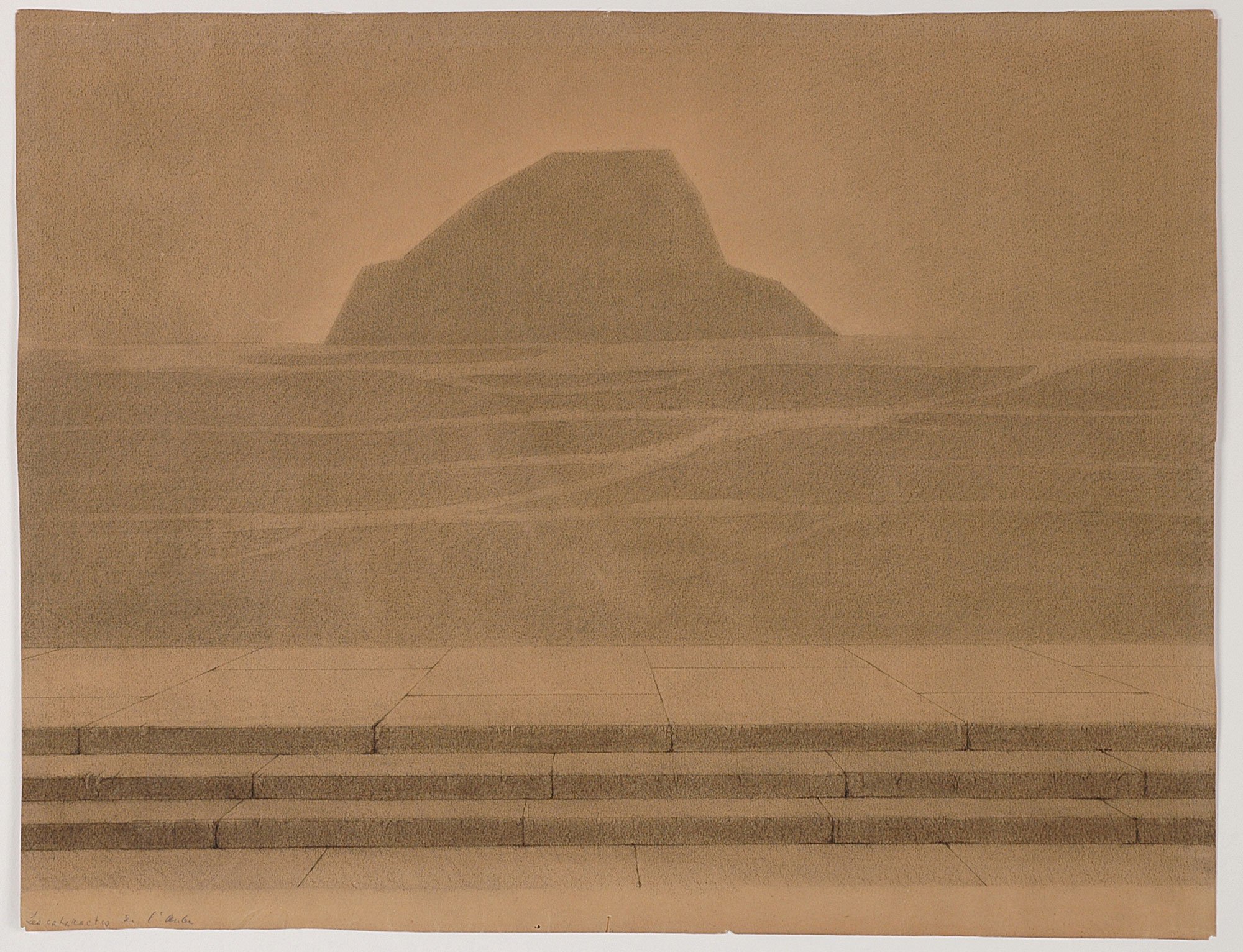
What also becomes apparent is that Appia only ever drew on the Ingres papers made by Canson & Montgolfier, famed for their constancy of texture and colour. The cotton-rag paper mills at Vidalon-lès-Annonay in southern France date all the way back to the sixteenth century and that is where the papers are still made today, in three self-contained factories sited on adjoining lots strung out over a distance of a mile along the banks of the fast-flowing river Dêume. By Appia’s time, the company had set up two international branches – one of them all the way over on 8th Avenue in New York, but the other much closer to home. The Dêume is a tributary of the Rhône, which on its way from the Swiss Alps to the Mediterranean flows through Geneva, and that is where the second branch was set up just twenty minutes’ walk from the Conservatoire, at 46 route de Frontenex. Appia restocked his paper supply there, every sheet of which bore the distinctive embossment ‘CANSON MONTGOLFIER à VIDALON-LES-ANNONAY à ANCNE MANUFRE’.
Notes
- The 30 cm x 20 cm notebook is bound in hard grey cardboard and made up of only 12 lined pages that are now yellowing, and that have each been numbered in pencil (1–12). The title page bears the following inscription, written in pencil in Appia’s neat looping hand: ‘Introduction to my personal notes / 1905’. It is held at the Swiss Archive of the Performing Arts (SAPA), Bern.
- Cited in Walter R Volbach, Adolphe Appia: Prophet of the Modern Theatre (Middletown, CT: Wesleyan University Press, 1968), p 45.
- Adolphe Appia, ‘Theatrical Experiences and Personal Investigations’. This is a 53-page manuscript that Appia wrote in pencil while he was detoxifying from Laudanum and alcohol at the Waldau psychiatric clinic in Bern in 1921. It is held at SAPA, Bern.
- Appia, preface to Die Musik und die Inszenierung (Munich: Bruckmann, 1899).
- Appia, Die Musik und die Inszenierung, p 93.
- Ibid, p 87.
- Ibid, p 274.
- Friedrich Nietzsche, Why I Am So Clever, trans R J Hollingdale. (London: Penguin, 2016), p 7.
- Houston Stewart Chamberlain to Appia, 24 November 1894.
- Cited in Volbach, Adolphe Appia: Prophet of the Modern Theatre, p 66.
- Cosima Wagner to Houston Stewart Chamberlain, 23 October 1888.
- Cited in Adolphe Appia, Œuvres Complètes, vol I: 1880–94, ed Marie L Bablet-Hahn (Lausanne: L’Age d’homme, 1983), p 39.
- Margaret Naumburg, ‘The Dalcroze Idea: What Eurhythmics Is and What it Means’, The Outlook (17 January 1914), p 127.
- Appia, ‘Theatrical Experiences and Personal Investigations’.
- Appia cited in Edmund Stadler, ‘Jaques-Dalcroze et Adolphe Appia’ in Frank Martin, ed, Émile Jaques-Dalcroze (Neuchatel: Eds de la Baconnière, 1965), p 418.
- Appia, ‘Theatrical Experiences and Personal Investigations’.
- Appia cited in Stadler, ‘Jaques-Dalcroze et Adolphe Appia’, p 418.
- Jean Mercier, cited in Walter Volbach, Adolphe Appia: Prophet of the Modern Theatre (Middletown, CT: Wesleyan University Press, 1968), p 120.
- I would particularly like to thank Simone Gfeller for her gracious assistance during the week that I spent poring over Appia’s drawings in December 2015.
- Adolphe Appia to Gordon Craig, 8 February 1916.

– Mark Dorrian